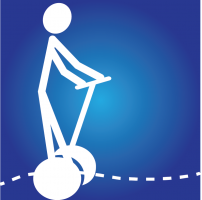 | 1 comment
| 1 comment
Lynda Bennet
Original article: Sadeghi M, McIvor J, Finlayson, H, Sawatzky B. Static standing, dynamic standing and spasticity in individuals with spinal cord. Spinal Cord, 2015, September [ doi: 10.1038/sc.2015.160]. Find the original article here
Have a spinal cord injury and experiencing problems with spasticity?
If you experience discomfort and pain caused by involuntary muscle spasms such as tendon jerks and contractions, you join the ranks of 65%-78% of people with a spinal cord injury (SCI). Medication, physical therapy, and in some cases surgery are used to obtain relief from these symptoms.
Of these, physiotherapy is a prevalent treatment. One can often reduce or eliminate the spasms by exercising (stretching, weight-bearing and strengthening), electrical stimulation, vibration, supported standing, and/or use of splints and braces.

A participant on the Segway
Previous studies indicate that supported standing training, a weight-bearing therapy, has potential benefits post-SCI. This treatment strives to improve posture, strengthen muscles, prevent cramping and reduce spasticity using a device that supports and braces you while you stand. There are two types of supported standing training: static where you use a stationary device and dynamic where you stand on a mobile device that you can move to different locations.
The Segway, a self-balancing electric-powered personal transport allows for both static and dynamic standing training. A previous pilot study showed that spasticity decreased significantly immediately after using a Segway, but its benefits faded over time. Which training method would you rather use? Which would benefit you more?
What was the purpose of this study?
This study examined the effects of standing training techniques on spasticity, dynamic (mobile Segway) and static (stationary Segway), to determine which type of training would reduce spasticity more. Researchers hypothesized that dynamic standing training would reduce spasticity more.
Who took part in this study?
Researchers recruited ten individuals living with SCI who met the following criteria:
- Were 18 to 65 years old
- Experienced a spinal cord injury more than 1 year
- Reported spasticity of their legs for at least 1 month before participating in the study
- Had the ability to rise from sitting to standing with no or little assistance from a person and/or with the use leg braces
How were the participants tested?
Each participant visited the research lab for an initial session to familiarize themselves with the environment and procedures. This was followed by two sessions on the Segway (one for static training and one for dynamic training). To control for factors that affect spasticity, participants arrived at the same start time and emptied their bladder before each session. They also maintained similar exercise regimes during the study period.
During the familiarization session, the participants’ level of spasticity was tested. The leg most affected by spasms was shaved and electrodes attached to specific muscle sites. Participants then received 10 minutes of training on the Segway.
Each standing training session lasted 20 minutes. To ensure safety, participants wore a harness system attached to a ceiling track. For the static standing session, the Segway was securely fixed with four blocks underneath the platform. The dynamic standing session involved four five-minute training periods:
- 0 to 5 minutes of slow forward and backward movements and stops
- 5 to 10 minutes of fast forward and backward movements and stops
- 10 to 15 minutes of narrow and wide turns to right and left
- 15 to 20 minutes where the participant was free to combine the movements
What was measured?
Three measurements assessed the effects of standing on spasticity in four muscle groups: the quadriceps (front of the thigh), hamstrings (back of the thigh), adductors (inside of the thigh), and gastrocnemius muscles (calves) for each session. As the primary measurement, researchers used the Modified Ashworth Scale (MAS) to assess resistance experienced through passive range of motion tests on the participant. Participant responses to a questionnaire measured their personal assessment of the level of spasticity in each muscle group (Visual Analog Scale VAS). In addition, researchers collected data to monitor the reflexive electrical activity of each muscle group to assess muscle spasticity against stretch (Electromyography or EMG).
What were the results?
Dynamic standing training revealed no additional beneficial effects for reducing spasticity reduction when compared with the results of static standing training as measured by clinical scale (MAS), self assessment (VAS), and electromyography results (EMG). However, the similar effects of both dynamic and static training suggest that dynamic training may have some role in managing spasticity in individuals living with SCI.

